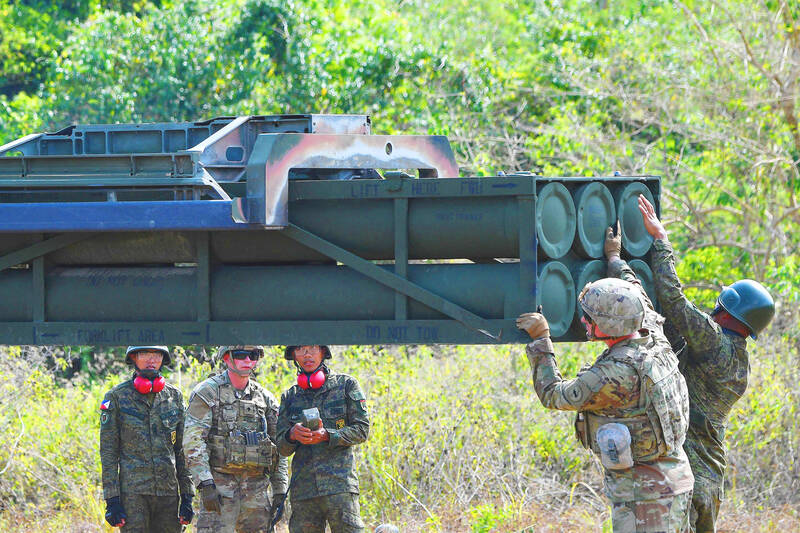Beijing yesterday warned that Washington was “endangering regional peace” in a new deal with the Philippines that would see four additional bases be used by US troops, including one near the disputed South China Sea and another not far from Taiwan.
“Out of self-interest, the US maintains a zero-sum mentality and continues to strengthen its military deployment in the region,” Chinese Ministry of Foreign Affairs spokesperson Mao Ning (毛寧)
“The result will inevitably be increased military tension and endangering regional peace and stability,” she added.

Photo: AFP
Longtime treaty allies Manila and Washington in February agreed to expand cooperation in “strategic areas” of the Philippines as they seek to counter Beijing’s growing assertiveness over Taiwan and China’s construction of bases in the South China Sea, where China and the Philippines, along with Taiwan, Brunei, Malaysia and Vietnam, have been locked in increasingly tense territorial disputes.
“That’s a trade route, that’s where more or less US$3 trillion worth of trade passes. Our responsibility in collectively securing that is huge,” Philippine Secretary of National Defense Carlito Galvez Jr said.
The 2014 Enhanced Defense Cooperation Agreement (EDCA) gave US forces access to five Philippine bases.
It was later expanded to nine, but the locations of the four new bases were withheld until Monday, while the government consulted with local officials.
The four sites had been assessed by the Philippine military and deemed “suitable and mutually beneficial”, the Philippine Presidential Communications Office said in a statement on Monday.
The US Department of Defense confirmed that the locations announced were the four new EDCA sites.
It also said in a statement it would add to the “US$82 million we have already allocated toward infrastructure investments at the existing EDCA sites,” without specifying by how much.
Three of the sites are in the northern Philippines, including a naval base and airport in Cagayan province and an army camp in the neighboring province of Isabela, Manila’s statement said.
The naval base at Cagayan’s Santa Ana is about 400km from Taiwan. Another site would be an air base on Balabac Island, off the southern tip of Palawan Island, near the South China Sea.
Cagayan Governor Manuel Mamba has publicly opposed having EDCA sites in his province for fear of jeopardizing Chinese investment and becoming a target in a conflict over Taiwan.
Galvez told reporters recently the government had already decided on the sites and that Mamba had agreed to “abide with the decision.”
Philippine President Ferdinand Marcos Jr’s office said the sites are “suitable and mutually beneficial,” and would “boost the disaster response of the country” as a springboard for humanitarian and relief work during emergencies.
The agreement allows US troops to rotate through the bases and also store defense equipment and supplies.
The locations “will strengthen the interoperability of the U.S. and Philippine Armed Forces and allow us to respond more seamlessly together to address a range of shared challenges in the Indo-Pacific region,” the US defense department said in a statement.
Additional reporting by AP

Asian perspectives of the US have shifted from a country once perceived as a force of “moral legitimacy” to something akin to “a landlord seeking rent,” Singaporean Minister for Defence Ng Eng Hen (黃永宏) said on the sidelines of an international security meeting. Ng said in a round-table discussion at the Munich Security Conference in Germany that assumptions undertaken in the years after the end of World War II have fundamentally changed. One example is that from the time of former US president John F. Kennedy’s inaugural address more than 60 years ago, the image of the US was of a country

‘UNUSUAL EVENT’: The Australian defense minister said that the Chinese navy task group was entitled to be where it was, but Australia would be watching it closely The Australian and New Zealand militaries were monitoring three Chinese warships moving unusually far south along Australia’s east coast on an unknown mission, officials said yesterday. The Australian government a week ago said that the warships had traveled through Southeast Asia and the Coral Sea, and were approaching northeast Australia. Australian Minister for Defence Richard Marles yesterday said that the Chinese ships — the Hengyang naval frigate, the Zunyi cruiser and the Weishanhu replenishment vessel — were “off the east coast of Australia.” Defense officials did not respond to a request for comment on a Financial Times report that the task group from

BLIND COST CUTTING: A DOGE push to lay off 2,000 energy department workers resulted in hundreds of staff at a nuclear security agency being fired — then ‘unfired’ US President Donald Trump’s administration has halted the firings of hundreds of federal employees who were tasked with working on the nation’s nuclear weapons programs, in an about-face that has left workers confused and experts cautioning that the Department of Government Efficiency’s (DOGE’s) blind cost cutting would put communities at risk. Three US officials who spoke to The Associated Press said up to 350 employees at the National Nuclear Security Administration (NNSA) were abruptly laid off late on Thursday, with some losing access to e-mail before they’d learned they were fired, only to try to enter their offices on Friday morning

STEADFAST DART: The six-week exercise, which involves about 10,000 troops from nine nations, focuses on rapid deployment scenarios and multidomain operations NATO is testing its ability to rapidly deploy across eastern Europe — without direct US assistance — as Washington shifts its approach toward European defense and the war in Ukraine. The six-week Steadfast Dart 2025 exercises across Bulgaria, Romania and Greece are taking place as Russia’s invasion of Ukraine approaches the three-year mark. They involve about 10,000 troops from nine nations and represent the largest NATO operation planned this year. The US absence from the exercises comes as European nations scramble to build greater military self-sufficiency over their concerns about the commitment of US President Donald Trump’s administration to common defense and